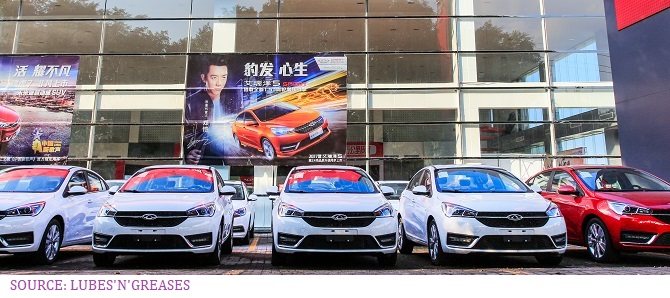Auto Sales Sag in China, India
SINGAPORE – Declining automotive sales in China and India are expected to impact demand for base oils, industry experts said at a conference last month.
“The transportation sector is still the biggest segment of the base oils market and likely to remain so in the coming years,” Izham Ahmad, senior editor of ICIS, said during a presentation at the Asian Industrial Lubricants Conference jointly organized by ICIS and the European Lubricating Grease Institute here last month.
China’s automobile production reached 18.1 million units during the first nine months of this year, down 11.4 percent from the same period of 2018, while sales declined 10.3 percent to 18.4 million units, according to the latest statistics released by the China Association of Automobile Manufacturers.
In 2018, China’s base oil consumption fell to 8.1 million metric tons, while a decline in industrial and manufacturing activities reduced demand for API Group I base oils. “Group II and Group III demand is stable to soft on lower demand for automotive lubricants due to falling car sales, expected to continue into 2020,” he added.
“Vehicle sales are slowing, and China mulls a goal that 60 percent of auto sales be electric [vehicles] by 2035,” Izham said
“As the market moves more towards EVs from [cars powered solely by internal combustion] engines, it is bound to impact engine oils and hence base oil demand,” Shailendra Gokhale, managing partner of Rosefield DAA International Consultancy, told Lube Report. “The good thing is that the shift is not going to be overnight, but in a gradual manner. The goal of 60 percent of auto sales [being electric] will definitely have a negative impact on base oils. However, in real [volume] terms, one should not forget that overall auto sales in China will be going up over the next 15 years, which means [internal combustion] engines and hybrids will also go up, and even in 2035, the vehicle parc of ICEs will still be high, which requires engine oils and hence base oils.”
The Chinese government reduced subsidies for EVs this year and is considering incentives to encourage construction of EV charging stations for consumers. “This will have a knock-on effect on the wider passenger vehicle market as EVs sales have been a major factor in helping to mitigate the overall slowdown. It will be a while, however, before the nationwide proliferation of charging points becomes a reality,” LMC Automotive, a United Kingdom-based business consultancy, said in its light vehicle sales report last month.
In India, “year-on-year automobile sales have been slowing and base oils demand from India’s passenger car segment not encouraging,” Izham said. During the first half of 2019, India’s base oil imports achieved year-to-year increases only in March and May.
Gokhale concurred. Tight credit conditions and economic slowdown affected passenger vehicle sales this year. “Impact on the aftermarket lubricant market is definitely felt, though it will not be as high as on factory-fill,” said Gokhale.
“While the next six months will certainly witness the demand of cars coming down due to transition to [India’s Bharat Stage VI emissions standard] by April 2020, I don’t think it will slow down demand for new cars. The demand of new cars will pick up as the economy of India picks up,” he added.
Despite the disruptions, Asia still dominates global base oil demand. He said current global demand is about 37 million tons, and half of that demand comes from Asia. However, in the past decade, “growth in Asian and developing economies barely compensated for the loss of demand in mature markets,” Izham said.
He pointed out that “regional imbalances between capacity and demand are evident for all the key [base oil] groups, generating trade flows. For example, in Asia, capacity of Group I matches demand, but there is an overcapacity of Group II and Group III. In North America, there is an overcapacity of Group I and Group II versus demand.”
